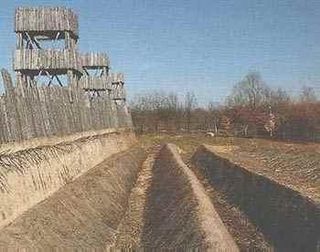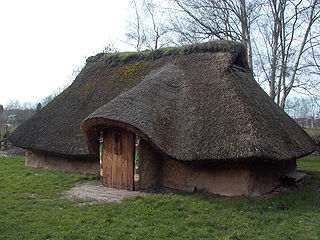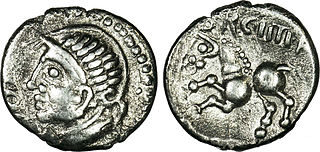Related Research Articles
The Aedui or Haedui were a Gallic tribe dwelling in what is now the region of Burgundy during the Iron Age and the Roman period.

Vercingetorix was a Gallic king and chieftain of the Arverni tribe who united the Gauls in a failed revolt against Roman forces during the last phase of Julius Caesar's Gallic Wars. After surrendering to Caesar and spending almost six years in prison, he was executed in Rome.

This article concerns the period 59 BC – 50 BC.

Gaul was a region of Western Europe first clearly described by the Romans, encompassing present-day France, Belgium, Luxembourg, and parts of Switzerland, the Netherlands, Germany, and Northern Italy. It covered an area of 494,000 km2 (191,000 sq mi). According to Julius Caesar, who took control of the region on behalf of the Roman Republic, Gaul was divided into three parts: Gallia Celtica, Belgica, and Aquitania.

Commentarii de Bello Gallico, also Bellum Gallicum, is Julius Caesar's firsthand account of the Gallic Wars, written as a third-person narrative. In it Caesar describes the battles and intrigues that took place in the nine years he spent fighting the Celtic and Germanic peoples in Gaul that opposed Roman conquest.

Year 58 BC was a year of the pre-Julian Roman calendar. At the time, it was known as the Year of the Consulship of Piso and Gabinius. The denomination 58 BC for this year has been used since the early medieval period, when the Anno Domini calendar era became the prevalent method in Europe for naming years.

The Arverni were a Gallic people dwelling in the modern Auvergne region during the Iron Age and the Roman period. They were one of the most powerful tribes of ancient Gaul, contesting primacy over the region with the neighbouring Aedui.

The Battle of Alesia or siege of Alesia was the climactic military engagement of the Gallic Wars, fought around the Gallic oppidum of Alesia in modern France, a major centre of the Mandubii tribe. It was fought by the Roman army of Julius Caesar against a confederation of Gallic tribes united under the leadership of Vercingetorix of the Arverni. It was the last major engagement between Gauls and Romans, and is considered one of Caesar's greatest military achievements and a classic example of siege warfare and investment; the Roman army built dual lines of fortifications—an inner wall to keep the besieged Gauls in, and an outer wall to keep the Gallic relief force out. The Battle of Alesia marked the end of Gallic independence in the modern day territory of France and Belgium.

The Menapii were a Belgic tribe dwelling near the North Sea, around present-day Cassel, during the Iron Age and the Roman period.

The Remi were a Belgic tribe dwelling in the Aisne, Vesle and Suippe river valleys during the Iron Age and the Roman period. Their territory roughly corresponded the modern Marne and Ardennes and parts of the Aisne and Meuse departments.

Bibracte, a Gallic oppidum, was the capital of the Aedui and one of the most important hillforts in Gaul. It was located near modern Autun in Burgundy, France. The material culture of the Aedui corresponded to the Late Iron Age La Tène culture.

Orgetorix was a wealthy aristocrat among the Helvetii, a Celtic-speaking people residing in what is now Switzerland during the consulship of Julius Caesar of the Roman Republic.

Dumnorix was a chieftain of the Aedui, a Celtic tribe in Gaul in the 1st century B.C. He was the younger brother of Divitiacus, the Aedui druid and statesman.

The Sequani were a Gallic tribe dwelling in the upper river basin of the Arar river (Saône), the valley of the Doubs and the Jura Mountains during the Iron Age and the Roman period.

Roman Gaul refers to Gaul under provincial rule in the Roman Empire from the 1st century BC to the 5th century AD.

The Battle of Bibracte was fought between the Helvetii and six Roman legions, under the command of Gaius Julius Caesar. It was the second major battle of the Gallic Wars.

Diviciacus or Divitiacus was a druid of the Aedui tribe who lived in Gaul during the 1st century BC. He is the only druid from antiquity whose existence is attested by name. The name may mean "avenger". His date of birth is unknown, though he was an adult during the late 60s BC, and an aristocrat who took part in the clans' decision-making, as described by Julius Caesar in Caesar's The Gallic War.

The Viromanduī or Veromanduī were a Belgic tribe dwelling in the modern Vermandois region (Picardy) during the Iron Age and Roman periods. During the Gallic Wars, they belonged to the Belgic coalition of 57 BC against Caesar.

The Gauls were a group of Celtic peoples of mainland Europe in the Iron Age and the Roman period. Their homeland was known as Gaul (Gallia). They spoke Gaulish, a continental Celtic language.
Gaius Valerius Troucillus or Procillus was a Helvian Celt who served as an interpreter and envoy for Julius Caesar in the first year of the Gallic Wars. Troucillus was a second-generation Roman citizen, and is one of the few ethnic Celts who can be identified both as a citizen and by affiliation with a Celtic polity. His father, Caburus, and a brother are named in Book 7 of Caesar's Bellum Gallicum as defenders of Helvian territory against a force sent by Vercingetorix in 52 BC. Troucillus plays a role in two episodes from the first book of Caesar's war commentaries, as an interpreter for the druid Diviciacus and as an envoy to the Suebian king Ariovistus, who accuses him of spying and has him thrown in chains.
References
- ↑ Julius Caesar, Commentaries on the Gallic War, Book I, 16
- 1 2 Julius Caesar, Commentaries on the Gallic War, Book VII, 33
- ↑ Christian Goudineau and Christian Peyre, Bibracte et les Éduens, À la découverte d'un peuple gaulois, éditions Errance, 1993
- ↑ Julius Caesar, Commentaries on the Gallic War, Book VII, 88"
- ↑ Jean-Pierre Bost et Jean Perrier, "Un vergobret à Augustoritum/Limoges sous le Haut-Empire romain", Travaux d'Archéologie Limousine tome 10 (1990), p. 27–32.
